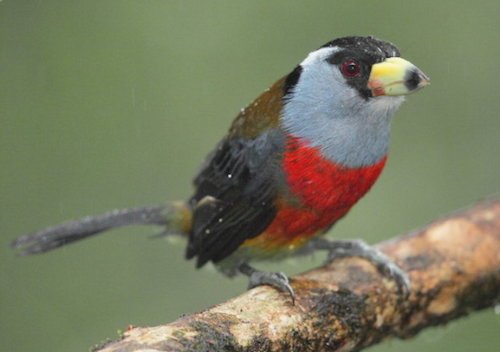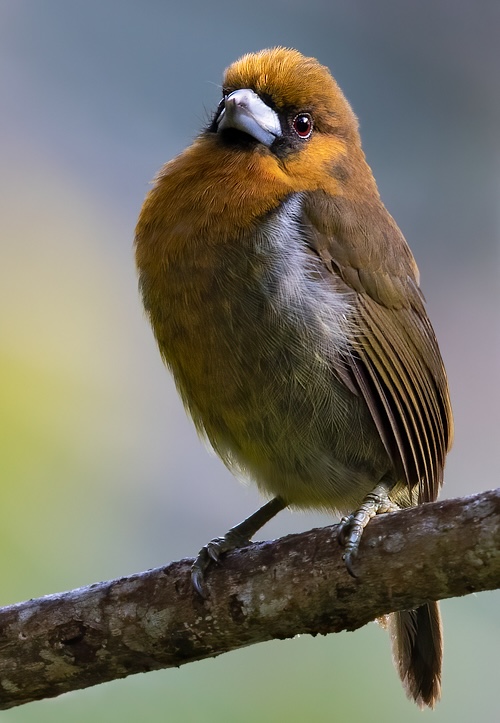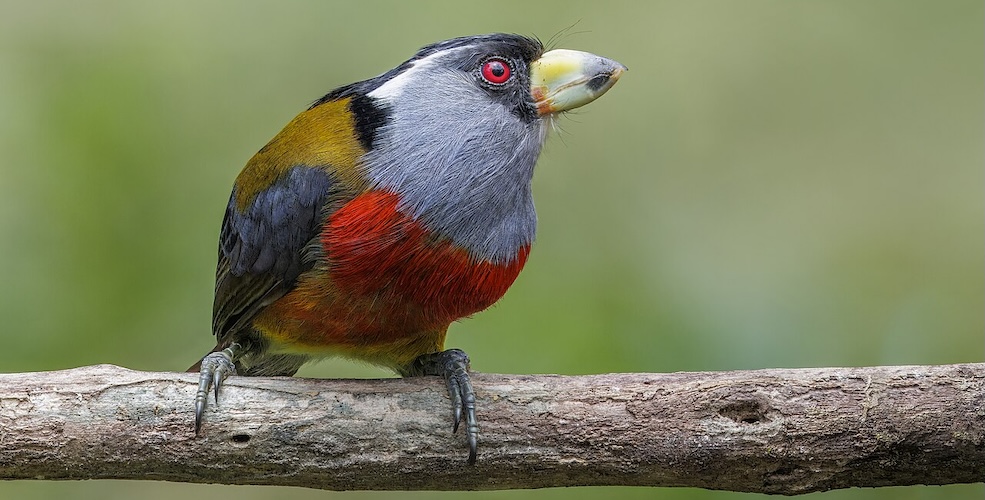Semnornithidae – Toucan Barbets

The Semnornithidae or Toucan-barbets are a small bird genus Semnornis. This was often included in the paraphyletic barbets but recently usually considered a distinct family. They form part of the order Piciformes, along with Lybiidae (African Barbets), Megalaimidae (Asian Barbets), Capitonidae (New World Barbets), Ramphastidae (Toucans), Indicatoridae (Honeyguides) and Picidae (Woodpeckers).
They are fairly large barbets, measuring between 18 and 21 centimetres. The Toucan Barbet is larger than the Prong-billed Barbet and considerably heavier. They possess large, swollen bills and lack strong sexual dimorphism in their plumage. The plumage of the Prong-billed Barbet is orange-brown, and that of the Toucan Barbet is more distinctively patterned with black, red, grey and gold.

Prong-billed Barbet Semnornis frantzii – ©Dubi Shapiro
They are found in the Neotropics. The Prong-billed Barbet is restricted to the humid highland forests of Costa Rica and Panama. The Toucan Barbet is found in similar habitats in the western montane forests of Ecuador and Colombia. In addition to primary forest, they may occupy forest edges and secondary growth. Neither species is migratory, and young birds do not appear to disperse very far after fledging; young toucan barbets only disperse 0.5 km. They are highly social, and may be seen either in small groups of up to five or six individuals, or as singles.
They are active during the day and are early risers. The prong-billed barbet sleeps in communal roosts at night in the non-breeding season. As many as 19 birds may roost together in a hole, either a modified nest or the abandoned nest of a woodpecker. During the breeding season pairs roost in their own nests. Both species of toucan-barbet are monogamous breeders. Prong-billed Barbets defend breeding territories from all others of their species. Toucan Barbets, on the other hand, have territories but are helped in raising the young by helpers.

Toucan Barbet Semnornis ramphastinus – ©Charles J Sharp CC BY-SA 4.0 via Wikimedia Commons
The diet of these two species is made up of fruits and insects. The ratio of the two is more similar to the toucans than other barbets and is dominated by fruits. A 1993 study of the stomach contents of these two species found only fruit. Fruits may be eaten whole, held in the foot and broken and eaten, or crushed and only the juices eaten. Insects are more common in the diet of nestlings, and compose 40% of the food brought to the nest in Toucan-barbets, which may also feed their chicks small numbers of vertebrates. They have also been recorded eating flowers.
-
Number of bird species: 2
(As at August 2025)
According to the recently (2025) combined AviList there are just two species in the Semnornithidae, a recently split family in just one genus. They are:
Prong-billed Barbet Semnornis frantzii
Toucan Barbet Semnornis ramphastinus
-
Semnornithidae
Family AccountThese two barbets appear to represent a deep branch in the history of the New World barbets and toucans. -
Semnornithidae
Family AccountThe genus was often included in the paraphyletic barbets, but recently is usually classified into a distinct family, Semnornithidae; alternatively, all...
Given that this is a tiny family with just two species in only one genus, Fatbirder provides several active links below to both species.
-
Prong-billed Barbet Semnornis frantzii
Species AccountAlthough this species may have a small range, it is not believed to approach the thresholds for Vulnerable under the range size criterion... -
Prong-billed Barbet Semnornis frantzii
Species AccountStrange brownish-yellow bird with thick silver bill and chunky body. Face and neck warm ochre; flanks silvery-gray. -
Prong-billed Barbet Semnornis frantzii
Species AccountThe prong-billed barbet (Semnornis frantzii) is a distinctive, relatively large-billed bird native to humid highland forest in Costa Rica and western Panama. -
Prong-billed Barbet Semnornis frantzii
Species AccountSound archive and distribution map. -
Tucan Barbet Semnornis ramphastinus
Species AccountA spectacular and iconic cloud forest bird of northwestern Ecuador and western Colombia. -
Tucan Barbet Semnornis ramphastinus
Species AccountThe toucan barbet (Semnornis ramphastinus) is a barbet in the family Semnornithidae native to the humid montane forests of western Ecuador and Colombia. -
Tucan Barbet Semnornis ramphastinus
Species AccountSemnornis ramphastinus is listed as Near Threatened under criteria A2cd+3cd+4cd. -
Tucan Barbet Semnornis ramphastinus
Species AccountSound archive and distribution map.
